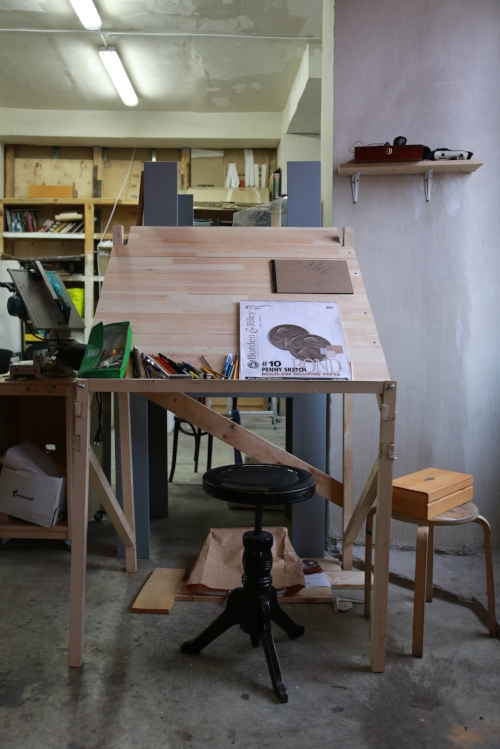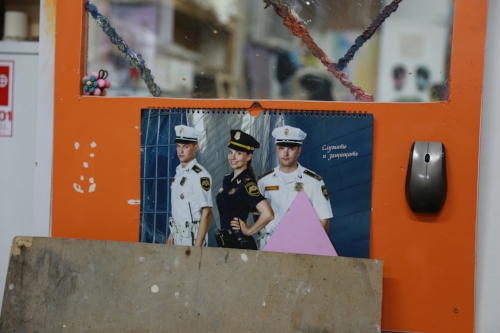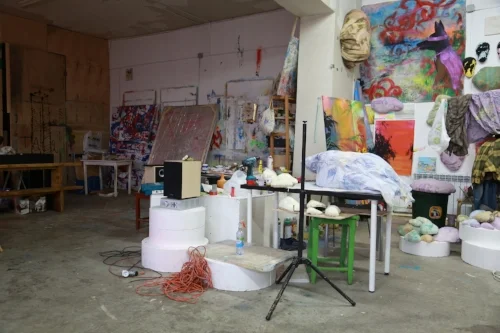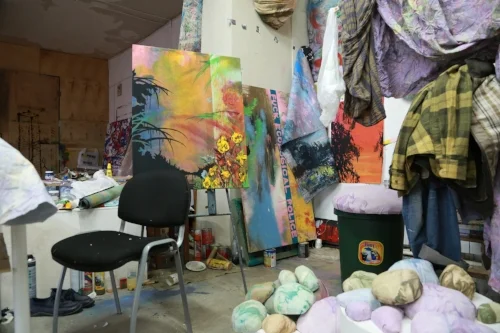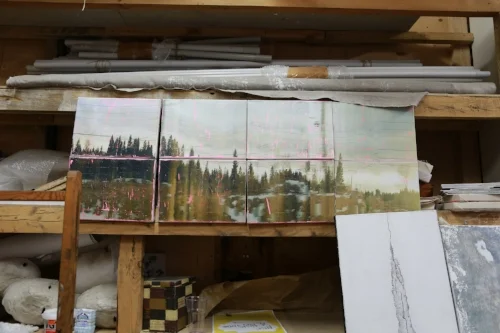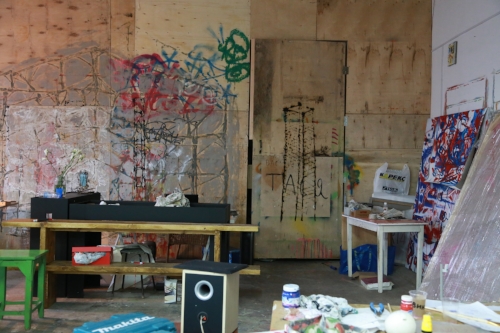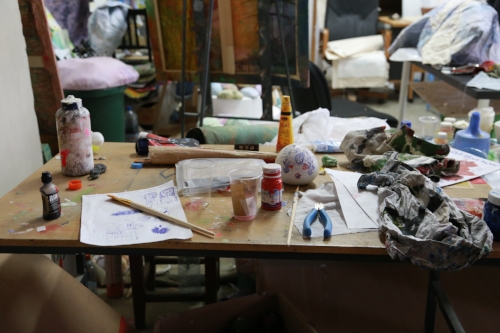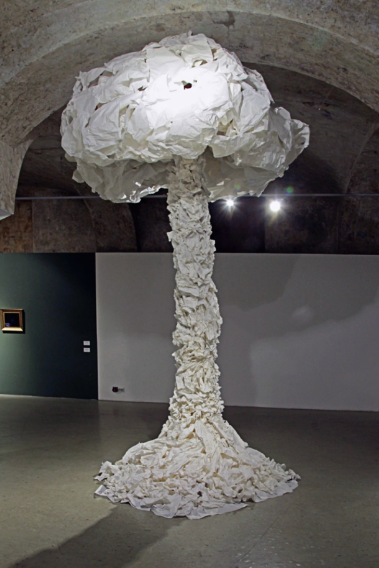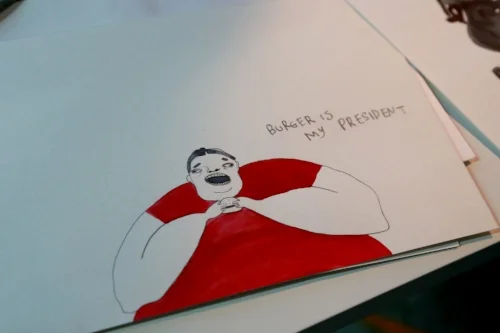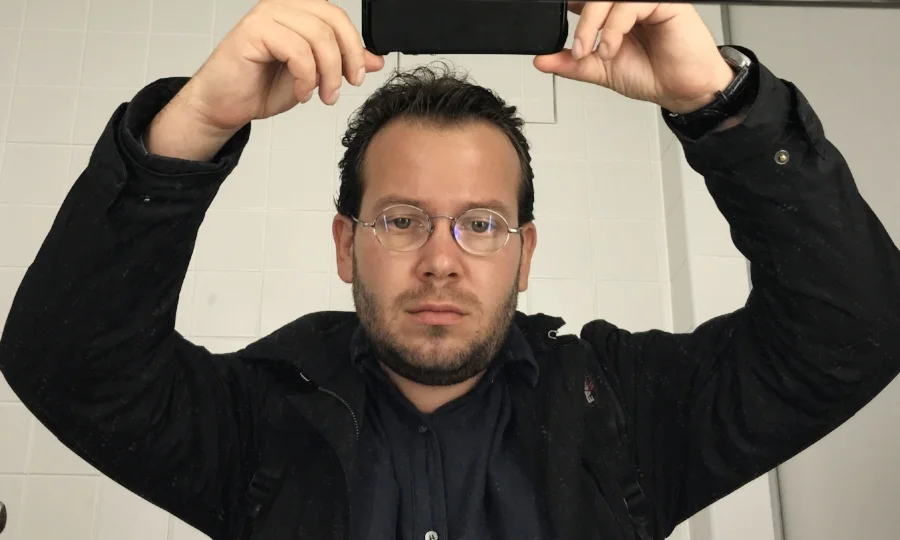Irina Petrakova, visual artist
On a grey yet bright afternoon, Kala and I wander into the Red October labyrinth. We are here to meet Irina, artist and founding member of Red Centr, an artist-run space.
No doubt you’re in Moscow: once we find the building, we need to call Irina and she motions us up from her window. Three floors later we enter a hostel (with all the cool yet a bit damaged style one can expect), push open a door to the left and enter a field of dry red carnations, above which hang black and white framed pictures.
Here we are : two rooms, a gallery and a studio, shared by 16 people who demonstrate in their own way that local democracy is an option.
Sasha and Irina hosted us in their non-compromising studio.
Can you tell us more about the studio, Red Centr (красный центр) ?
Irina and Sasha : Most of the co-founders met at BAZA (University Art Anatoly Osmolovsky) and work in the art field. Two years ago, our need was to find a place to work, a studio. We read the classified ads, found this place and decided to share the rent. We are aware that it’s impossible for 16 people to work together in the same room. But it works because we are a flexible community with different types of activities : curators, writers, producers don’t need to work in the studio every day.
We agreed on our common artistic strategy and there is a planning for all events in the gallery. We organize meetings once or twice a month and vote for each proposition.
What is this artistic strategy you all share ?
Irina and Sasha : The first idea was not to belong to any official institutions. As a member, even though one doesn’t always like every event we do, one is free to do his own thing. We are not a commercial gallery. We are against commercial art and this space is about being free from the market’s alleged expectations. Sometimes we sell and welcome customers, but it is not our main goal here.
The first year we didn’t exhibit any of the members just to be more objective. We show things that couldn’t be shown anywhere else in Moscow. For the 2nd year, we did personal exhibition of each member and now we are mixing both.
We are thinking now about being better organized and open to the ecosystem, to communicate more to widen our audience. But without losing our free spirit : last year we did an art sale of center’s artworks with a fixed price 100€. It was all a joke about other famous auctions.
What do you think about Moscow art scene ?
Irina and Sasha : Some say there is a crisis in art industry. We don’t share this view, we think there is no art industry in Russia. There are still as many galleries as ten years ago. It may be compared with EU or the US at the beginning of the 20th century. It is a teenage market with too few buyers.
However, there are some new formats like pop-up shows, auctions and it’s growing.
Can you tell me a bit more about you : how did you become an artist ?
Irina : I studied Fine Arts in the state university in Novosibirsk (15:16). It was a classical education (painting, composition). After graduation, I worked a few years as a PR freelance but I never stopped practising drawing. Then I quit my regular office career because I feel unhappy and decided to be an artist. Now I don’t have money but I’m happy. I guess it is a common situation among russian artists and it is still considered marginal.
How do you work ?
Irina : I don’t really have any routine except I draw every day.
I do intellectual or conceptual researches but at the same time I practice surrealistic methods like automatic writing, frottages and etc.
There is a moment when it all combines and I do preliminary graphics about the piece and then the piece itself.
As an artist, do feel any kind of a responsibility towards society ?
An artist isn’t able to work for himself. It’s always a dialogue with other people, with society… Artists have the responsibility to show some hidden and disgusting things, to go beyond beauty to show people not only the beautiful but also the very powerful and cruel reality. I believe we have something to say and that it has an influence on culture. I am not talking about high culture but about everyday life’s actions and things, and to make it more wide.
Do you think there’s something specific about being a woman artist here and now ?
Irina: For me, it’s the same. I think I communicate like a human, not really like an artist and for sure not like a “woman artist”.
How do you look for inspiration?
Inspiration comes from a common thinking of contemporary being. A lot of very initial things are changing now as we move from analog to digital or cloud era, and it’s impact the basic statements of our being, like a national identity, for example. Here i want to mention the Manifesto of the Chtonic movement, which we compose and publish with another Center Red’s artists. It says that culture is concentrate in a small and unspeakable and unnoticable elements encapsulated in the language and transmitted from generations to generation, and it’s really far from official history, national museums and “high culture”. So it’s nesessary to work with this basic and hidden elements to change the whole culture. We commit to discover theses small elements through our art and transform and update the very initial elements.
What about our digital era : does it have an impact on your work ?
Some are using digital to claim they are fashionable contemporary artists. To me it is more about a media among others to transform an idea into an artwork, which is my main practice. Using digital is sometimes relevant when it creates great interactions and artistic effects. In addition to that, being on FB or Instagram makes it easier to communicate with your audience and make your art spread and meet a new audience.
Thanks a lot Irina and Sasha for the afternoon we spent together. Discovering your functioning as a collective was truly inspiring as knowing more about Irina's artistic approach was very enlightening. You embody the young, strong and powerful arty generation !
Follow the news :
Credits : All pictures by Kala Court.
